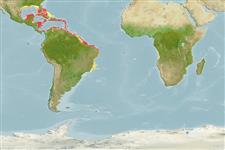Teleostei (teleosts) >
Tetraodontiformes (Puffers and filefishes) >
Ostraciidae (Boxfishes)
Etymology: Lactophrys: Latin, concerned with milk + Greek, ophrys = eyebrow (Ref. 45335).
More on author: Linnaeus.
Issue
Matsuura (2003: Ref. 53032) places this species in the genus Rhinesomus.
Environment: milieu / climate zone / depth range / distribution range
Ecology
Marine; reef-associated; depth range 3 - 50 m (Ref. 11227). Subtropical; 32°N - 35°S, 99°W - 14°W
Western Atlantic: Florida (USA), Bahamas, and southern Gulf of Mexico to Brazil. Eastern Atlantic: Ascension Island (Ref. 3696).
Size / Weight / Age
Maturity: Lm ? range ? - ? cm
Max length : 48.0 cm TL male/unsexed; (Ref. 7251); common length : 20.0 cm TL male/unsexed; (Ref. 5217)
Whitish with numerous small black spots on carapace, caudal peduncle and caudal fin; lips whitish; bases of dorsal, anal and pectoral fins blackish; large adults with black spots missing from three small areas in a diagonal row anteriorly on body at level of eye, appearing as three white spots (Ref. 13442).
Found in clear water around coral reefs. Sometimes under ledges and near small holes (Ref. 9710). Feeds on a variety of small bottom invertebrates such as mollusks, crustaceans, starfishes, sea urchins, sea cucumbers, sessile tunicates, sea grasses (Ref. 3696), algae, crabs and brittle stars (Ref. 13442). Toxins released when excited kills other fishes (Ref. 5521). Probably marketed fresh locally (Ref. 3696).
Life cycle and mating behavior
Maturities | Reproduction | Spawnings | Egg(s) | Fecundities | Larvae
Robins, C.R. and G.C. Ray, 1986. A field guide to Atlantic coast fishes of North America. Houghton Mifflin Company, Boston, U.S.A. 354 p. (Ref. 7251)
IUCN Red List Status (Ref. 130435)
Threat to humans
Reports of ciguatera poisoning (Ref. 30911)
Human uses
Fisheries: commercial; aquarium: commercial
Tools
Special reports
Download XML
Internet sources
Estimates based on models
Preferred temperature (Ref.
123201): 25.4 - 28, mean 27.3 °C (based on 200 cells).
Phylogenetic diversity index (Ref.
82804): PD
50 = 0.6250 [Uniqueness, from 0.5 = low to 2.0 = high].
Bayesian length-weight: a=0.03548 (0.01700 - 0.07404), b=2.81 (2.62 - 3.00), in cm total length, based on LWR estimates for this (Sub)family-body shape (Ref.
93245).
Trophic level (Ref.
69278): 3.2 ±0.2 se; based on diet studies.
Resilience (Ref.
120179): High, minimum population doubling time less than 15 months (Fec assumed to be > 10,000).
Fishing Vulnerability (Ref.
59153): Moderate vulnerability (38 of 100).
Nutrients (Ref.
124155): Calcium = 23.4 [9.0, 73.1] mg/100g; Iron = 0.605 [0.299, 1.439] mg/100g; Protein = 19 [17, 21] %; Omega3 = 0.158 [0.081, 0.301] g/100g; Selenium = 20.2 [8.6, 44.3] μg/100g; VitaminA = 22.2 [5.5, 97.3] μg/100g; Zinc = 0.693 [0.441, 1.110] mg/100g (wet weight);
